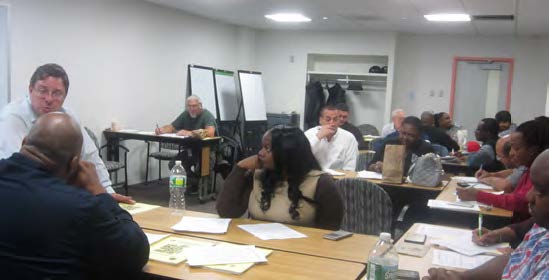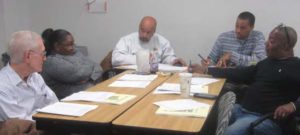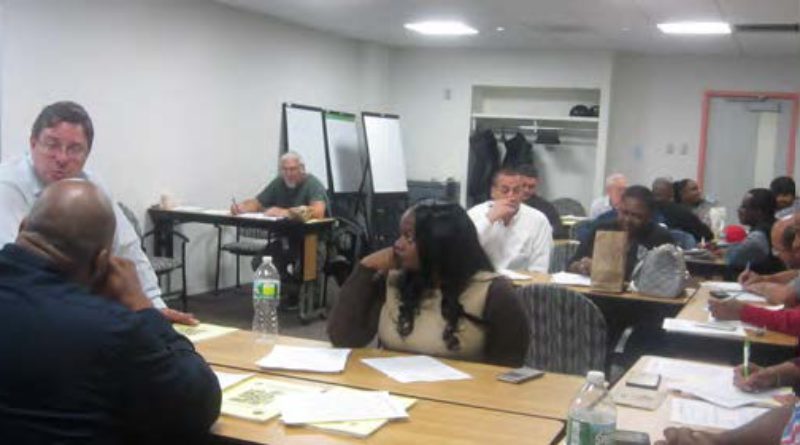New Safety Investigation Program Launches

NYCHA’s Office of Safety and Security (OFSS) or a specially trained Incident Investigation Team conducts a thorough analysis of every serious onthe- job injury or accident to determine its root causes to prevent future incidents. But what about minor injuries like cuts or bruises that don’t require hospitalization or result in lost time from work?
To ensure that important lessons are learned from even minor mishaps, NYCHA is implementing an extensive Injury Investigation Training Program for up to 3,000 property managers, property maintenance supervisors, skilled trades supervisors and other employees across NYCHA.
“The mandatory training in ‘root cause analysis’ and investigation will help NYCHA workers identify what went wrong or what system failed, [causing] an injury,” said Human Resources Deputy Director Cherry McCutchen. “What’s even more important are the lessons about corrective action recommendations to prevent or avoid injuries in the future.”
At one of the two-day training sessions held at 250 Broadway, environmental consultant Drew Pardus told employees that “every employee wants to go home in the same condition they arrived in. Yet at NYCHA approximately 200 workers are out every day because of an injury that occurred on the job.” In investigating the reasons for these injuries, he explained, “we will be looking for the causes of accidents, not the blame.”
The early part of the training stressed the importance of:
- arriving early and securing the scene of the accident;
- notifying the proper supervisor;
- carefully gathering and inspecting evidence and information;
- getting statements from witnesses; and
- preserving information for an advanced injury investigation team.
Through lively discussions of real case studies, employees practiced making sharp observations and avoiding assumptions while drawing conclusions from events and details. “We’re trying to find and put together all the pieces in the puzzle,” Mr. Pardus said. “Not just what happened but, most important, what led up to it.”
During a class break, Carver Houses Property Manager Helen George said, “It will be helpful to know what questions to ask when accidents occur to find out the real cause.
Bushwick Houses Property Maintenance Supervisor Santiago Eduardo remarked, “This training will help me to be more hands-on when directly investigating the causes of accidents.”
Case Studies
The discussion of one scenario —where a superintendent fell from a ladder affixed to a roof tank after noticing a “funny smell”—revealed a number of possible causes and contributing factors. These included: non-compliance with prescribed procedures requiring a spotter for the ladder, a field radio, and a safety harness; a possible preexisting medical condition; and exposure to chemicals. Class discussion revealed that only vendors are now permitted to use roof tank ladders, due to the risk of injury.
Another case study focused on a caretaker splashed in the eye when opening a sealed cap from a floor stripper. Possible root causes for this incident included lack of protective equipment (safety goggles), lack of training for hazardous materials, and a defective container.
Breaking up into small groups, the class was then asked to list all the steps involved in a task performed by a group member so that its elements could be examined in greater detail. “Once you identify the root causes, what are you going to do about it?” Mr. Pardus asked. In some cases, placing more warning signs and safety messages would be helpful; other times, alerting staff during weekly safety meetings to certain safety hazards was advised.

“When you work with something for a long time, you can lose the sense of risk in it,” Mr. Pardus said. A comprehensive Field Operations Guide distributed in class provided additional information on preventing, investigating, analyzing and reporting accidents and injuries for the participants, many of whom will serve on Location Safety Teams at developments that investigate less serious safety incidents.
The Field Operations Guide also supports borough Incident Investigation Teams that respond to more complicated incidents.
The large-scale location training initiative also included 30-minute “toolbox talks” conducted by NYCHA and Teamsters Local 237 during “musters” this summer at 175 developments. The talks provided an overview of the root cause analysis approach to incident investigation.
“This is our largest-ever agency-wide safety training initiative and it reflects the priority placed on employee safety in NextGeneration NYCHA,” said OFSS Director Patrick O’Hagan. “Investing in on-the-job safety is the right thing to do because it makes financial sense, operational sense and — most important — human sense.”







